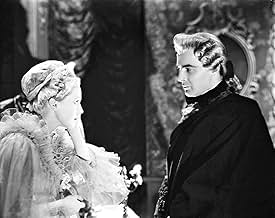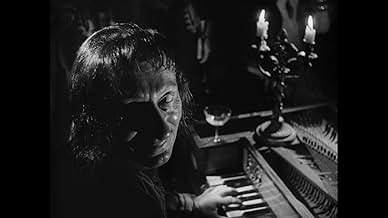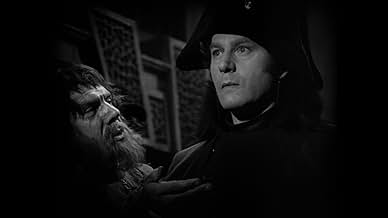Adicionar um enredo no seu idiomaAn army officer becomes obsessed with learning the secret to a card game for which an elderly countess sold her soul years earlier.An army officer becomes obsessed with learning the secret to a card game for which an elderly countess sold her soul years earlier.An army officer becomes obsessed with learning the secret to a card game for which an elderly countess sold her soul years earlier.
- Direção
- Roteiristas
- Artistas
- Indicado para 1 prêmio BAFTA
- 3 indicações no total
- Countess's Lover
- (as Yusef Ramart)
- Direção
- Roteiristas
- Elenco e equipe completos
- Produção, bilheteria e muito mais no IMDbPro
Avaliações em destaque
I was fortunate enough to see it on cable, where by coincidence it was shown right after 'The Third Man' and just before another Brtish b/w masterpiece, 'The Haunting' -- what a triple bill! In fact there are several connections between QOS and 'The Haunting', including Jack Clayton, who produced the former and directed the latter, and composer Georges Auric, who scored both. There are also close connections with The Archers (Powell & Pressberger) -- Anton Walbrook featured in three P&P films, and co-writer Rodney Ackland also scripted one of those films, P&P's '49th Parallel'.
Watching 'Queen Of Spades' it's obvious that many of the team who made it learned their craft in the silent era -- lighting, costumes, set design and cinematography are all fantastic, and though on a slightly smaller and more restrained scale, QOS is almost on a par with Von Sternberg's baroque masterpiece 'The Scarlett Empress'.
Brilliantly directed by Torold Dickinson (who also did 'Gaslight', in which Walbrook also features), the incredible, wildly expressionistic b/w cinematography is by legendary Czech-born DOP Otto Heller, who began his career in 1922(!) and who also shot Olivier's 'Richard III', 'The Ladykillers', Powell's 'Peeping Tom' and those three classic Michael Caine films of the 60s, The 'Ipcress File', 'Alfie' and 'Funeral In Berlin.'
The casting is perfect, and it's easy to see why Anton Walbrook was one of Michael Powell's favourite actors. His portrayal of the odious Suvorin is a tour de force, and he is matched by the great Edith Evans as the Countess. The crucial scene in which Suvorin tries unsuccessfully to beg, cajole, and finally force the secret of the cards from the Countess is truly electrifying -- Walbrook is absolutely rivetting, and Evans -- who has no lines and plays the scene only with her eyes -- shows why she was considered one the greatest actors of her generation. The climax of that scene, the look of stark horror on Walbrook's face, is one of the most powerful film moments I've ever seen, perhaps only surpassed by incredible card-game scene at the end of the film.
Anton Walbrook may have played more multi-dimensional characters in other films, but never with the same frightening intensity as in this one. The cast is uniformly excellent, but it's his performance as Hermann that really makes the film memorable. Hermann is a strange sort of cinematic hero with no redeeming characteristics whatsoever. His personality is dominated by four of the seven deadly sins: pride, envy, wrath, and greed. As for lust, he lusts only for power, money and influence, his declarations of love being completely false. Gluttony is not an issue, as he lives in poverty in order to horde what money he has. As for sloth, he exerts extraordinary effort into fulfilling his schemes, which are entirely self-serving. Sounds like a thoroughly unpleasant fellow. But Walbrook makes this brooding, scheming, petty, and utterly reprehensible nonentity with a Napoleon complex into a fascinating character study -- a real tour-de-force. The Vienna-born Walbrook (originally named Adolph Anton Wilhelm Wohlbrueck) exaggerates his Teutonic accent to Peter Lorre-like intensity, to great effect. It's this film that made him one of my all time favorite actors.
The look of this film is also extraordinary. Even in this pristine presentation, the cinematography is very dark and deeply shadowed. The shadowy look of the film, along with some oddly angular or distorted shots, is suggestive of expressionist style. The story is told very directly and the plot moved along efficiently, with no superfluous action, which adds to the unreal atmosphere of the piece. Everything associated with the story seems to take place in quick succession. In a city as huge as St. Petersburg, Hermann wanders from the spooky booksellers' shop directly to the old countess's house purely by chance. Every element of the story is essential, and executed with maximum effect and style. The funeral scene in particular is unforgettable.
What a pleasure to find that this terrific, but relatively obscure, film has finally gotten a DVD release, and looks better than I've ever seen it looking. Almost everyone who's commented on it cites the fact that it is little known, and maybe this new DVD will change that a bit.
A Tale of Old St. Petersbvrg.
"In 1806 the craze for gambling had spread throughout Russia. Faro-a simple card game similar to our snap-was all the fashion, and fortunes were won and lost on the turn of a card. As a result there arose many superstitions concerning the cards-one of these was the evil influence of THE QVEEN OF SPADES."
The dead shall give up their secrets.
Haunting, poetic, lyrical, romantic and visually arresting, Thorold Dickinson's take on the Pushkin story is a magnificent picture of many wonders. It's a film that (thankfully) is hard to pigeon hole, it's very unique, a uniqueness that marks it out as an oddity of sorts, ensuring it has stayed as a cult classic rather than a mainstream one. However, now widely available on DVD (the Optimum Region 2 issue is a spankingly fine transfer), and with Martin Scorsese lending his weight to the film's greatness, it's hoped that more people will get to see and embrace this masterpiece.
Dickinson (Gaslight) was only brought in at the last minute, literally days before the picture went into production. Armed with only a tiny budget and confined to the stages of Welwyn Studios, the director gave a lesson in classic film making. The story is a more than solid source to work from, Walbrook's Tsarist Captain Suvorin aspires to gain wealth by learning Countess Ranevskaya's (Evans) secret to wining at the card game Faro. Working from a book he located about people making deals with the Devil, Suvorin worms his way into the affections of the Countess' ward, Lizaveta Ivanova (Mitchell), so as to get close to the aged and fragile Countess and put the squeeze on the old dear. He is obsessed and oblivious to the feelings of others and ignorant to the age old adage about being careful about what you wish for.....
Filmed in subtle black and white by Otto Heller (They Made Me A Fugitive), film is big on shadows, odd camera angles, clinical sound work and haunting imagery. Atmosphere is everything in a film like this, and this has it in abundance, even during the more exuberant passages, such as the gaiety of a dance, there's a disquiet hanging in the air, William Kellner's brilliantly baroque sets observers of impending doom. A number of images burn into the soul, a spider climbing its web, a doused candle and the eerie sight of distorted figurines in glass jars, these are just some of the shots worthy of inspection. Mirrors, too, play a prominent part in proceedings, hauntingly so, while many of the characters have an other worldly sheen to them.
3, 7 & Ace.
Mostly the film is highly thought of by those that have seen it, what negative reviews I have come across appear to be written by horror fans unhappy with not getting the horror film suggested by tag words such as ghost and the Devil. For the first hour it's pretty much about characterisations, psychological make ups and back story, it's not until the hour mark when things start moving towards the spooky. But this film is not horror, as mentioned earlier, it's hard to pigeon hole it for it covers a number of bases. It's more in line with Rebecca and either of the Gaslight movies, an opulent period piece with supernatural overtones, while the visual style of it is very much like The Spiral Staircase. If you like those movies? Then it's pretty nailed on that this is the movie for you. Cast are terrific, Walbrook (Gaslight/The Red Shoes) is intense and maniacal, Evans (The Importance of Being Earnest) is oddly scary but pitiful, Mitchell is beautiful but perfectly staid and Howard (son of Leslie) is straight backed and gentleman like.
From the opening credits that are off kilter written on scratchy looking paper, accompanied by Auric's blunderbuss music score, to the "devilment" of the denouement, this is a classic Ealing film for true classic film fans. 10/10
Você sabia?
- CuriosidadesThe studio was right beside a train line and very badly sound-proofed. They had to post a man on the studio roof to watch out for trains so filming could be suspended while the trains went past.
- Citações
Capt. Herman Suvorin: [he surprises the Old Countess] Don't cry out! Don't be alarmed, please, don't be alarmed. I don't mean you any harm. I've come to ask a favour of you. That's all. A favour. It'll cost you nothing. But to me, it will bring happiness for the rest of my life. I want the secret of the cards. That's all. Come, what is it? The three cards. The names of the three cards. Please! Oh, it's no use pretending you don't know anything about it. I know you were given the secret. And I know who gave it to you. Please! Just think those three words aloud. And I'll trouble you no more. I'll go. What good is the secret to you? For whom are you keeping it? For your grandson? He's rich enough. What would another fortune mean to him, a wastrel and a spendthrift? But I'm not a man of that sort. I know the value of money. I could do great things, I tell you. Great things! If only I had money.
Capt. Herman Suvorin: [sinking to his knees, he continues] For the love of God! If you've any human feeling in your breast, you can't refuse me. I beg. I beseech you. I know why you won't speak. The secret is connected with some terrible sin. That's it, isn't it? I'll make a bargain with you; tell me your secret and I'll take your sin upon my soul. Do you hear me? I mean it. A bargain. I'll take your sin upon my own soul. Oh, speak! Speak to me! You old sphinx.
Capt. Herman Suvorin: [he brandishes a pistol and continues] By God, I'll make you. I ask for the last time, are you going to tell me the secret of the cards? Or are you not?
- Cenas durante ou pós-créditosThe opening credits, rather than simply reading "Screenplay By", "Music By", "Director of Photography", etc., as in most films, read "The Screenplay By", "The Music By", "The Director of Photography", "The Art Director", etc.
- ConexõesReferenced in Carta da Sibéria (1958)
Principais escolhas
- How long is The Queen of Spades?Fornecido pela Alexa
Detalhes
- Data de lançamento
- País de origem
- Idioma
- Também conhecido como
- The Queen of Spades
- Locações de filme
- Empresas de produção
- Consulte mais créditos da empresa na IMDbPro
- Tempo de duração1 hora 35 minutos
- Cor
- Proporção
- 1.37 : 1
Contribua para esta página



































